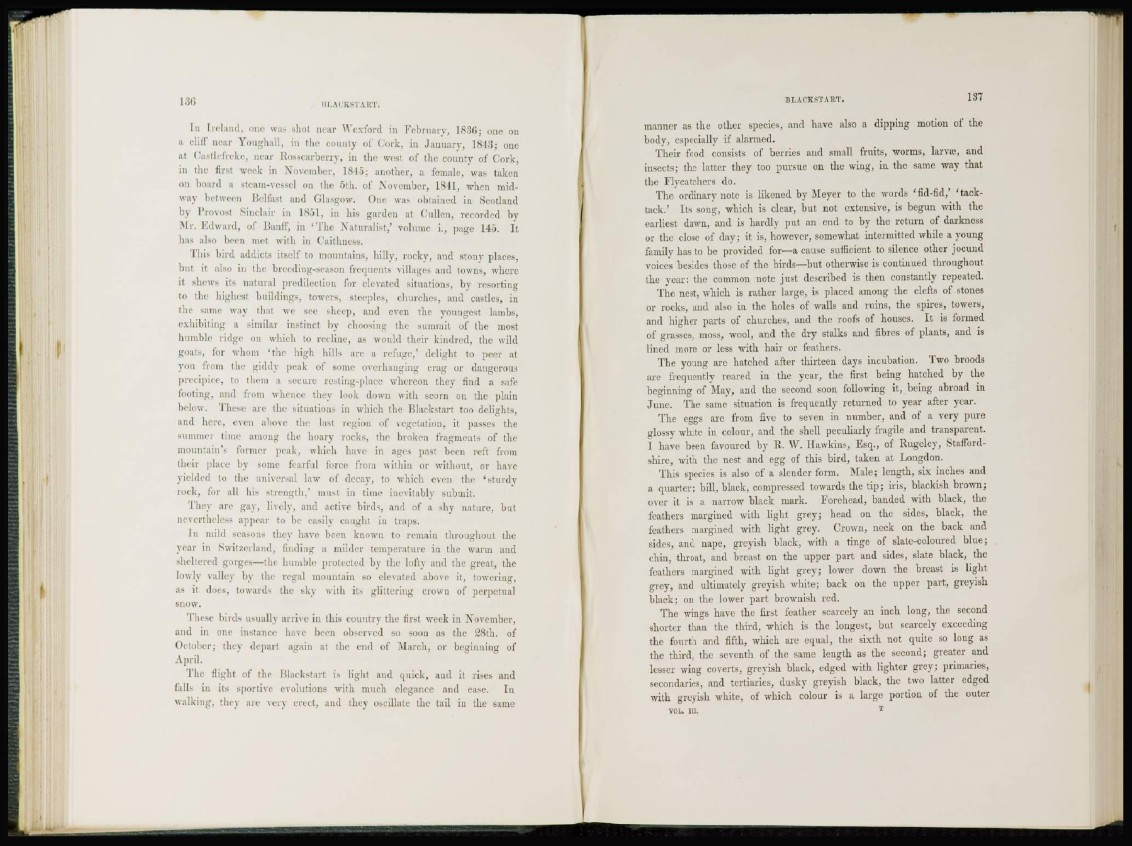
136 BLACKS'] ART.
In Ireland, one was shot near Wexford in February, 1836; one on
a cliff near Youghall, in the county of Cork, in January, 1843; oue
at Castlefreke, near Rosscarberry, in the west of the county of Cork,
in the first week in N member, 1845; another, a female, was taken
on board a steam-vessel on the 5th. of November, 1841, when midway
between Belfast and Glasgow. One was obtained in Scotland
by Provost Sinclair in 1851, in his garden at Cullen, recorded by
Mr. Edward, of Banff, in ' The Naturalist,' volume i., page 140. It
has also been met with in Caithness.
This bird addicts itself to mountains, hilly, rocky, and stony places,
but it also in the breeding-season frequents villages and towns, where
it shews its natural predilection for elevated situations, by resorting
to the highest buildings, towers, steeples, churches, and castles, in
the same way that we see sheep, and even the youngest lambs,
exhibiting a similar instinct by choosing the summit of the most
bumble ridge on which to recline, as would their kindred, the wild
goats, for whom 'the high bills are a refuge,' delight to peer at
you from the giddy peak of some overhanging crag or dangerous
precipice, to them a secure resting-place whereon they find a safe
footing, and from whence they look down with scorn on the plain
below. These arc the situations in which the Blackstart too delights,
and here, even above the last region of vegetation, it passes the
summer time among the hoary rock's, the broken fragments of the
mountain's former peak. which have in ages pasl been reft from
their place by some fearful force from within or without, or have
yielded to the universal law of decay, to which even the ' sturdy
rock, for all his strength,' must in time inevitably submit.
They are gay, lively, and active birds, and of a shy nature, but
nevertheless appear to be easily caught in traps.
In mild seasons they have been known to remain throughout the
year in Switzerland, finding a milder temperature in the warm and
sheltered gorges—the humble protected by the lofty and the great, the
lowly valley by the regal mountain so elevated above it, towering,
as it does, towards the skj with its glittering crown of perpetual
snow.
These birds usually arrive in this country the first week in November,
and in one instance have been observed so soou as the 38th. of
October; they depart again at the end of March, or beginning of
April.
The flight of the Blackstart is light and quick, and it rises and
tails in its sportive evolutions with much elegance and ease. In
walking, they are very erect, and they oscillate the tail in the same
BLAOKSTAItT. 137
manner as the other species, and have also a dipping motion of the
body, especially if alarmed.
Their food consists of berries and small fruits, worms, larva?, and
insects; the latter they too pursue on the wing, in the same way that
the Flycatchers do.
The ordinary note is likened by Meyer to the words * fid-fid,' 'tacktack.'
Its song, which is clear, but not extensive, is begun with the
earliest dawn, and is hardly put an end to by the return of darkness
or the close of day; it is, however, somewhat intermitted while a young
family has to be provided for—a cause sufficient to silence other jocund
voices besides those of the birds—but otherwise is continued throughout
the year: the common note just described is then constantly repeated.
The nest, which is rather large, is placed among the clefts of stones
or rocks, and also in the holes of walls and ruins, the spires, towers,
and higher parts of churches, and the roofs of houses. It is formed
of grasses, moss, wool, and the dry stalks and fibres of plants, and is
lined more or less with hair or feathers.
The young are hatched after thirteen days incubation. Two broods
are frequently reared in the year, the first being hatched by the
beginning of May, and the second soon foUowing it, being abroad in
June. The same situation is frequently returned to year after year.
The eggs are from five to seven in number, and of a very pure
glossy white in colour, and the shell peculiarly fragile and transparent.
I have been favoured by R. W. Hawkins, Esq., of Rugeley, Staffordshire,
with the nest and egg of this bird, taken at Longdon.
This species is also of a slender form. Male; length, six inches and
a quarter; bill, black, compressed towards the t i p ; iris, blackish brown;
over it is a narrow black mark. Forehead, banded with black, the
feathers margined with light grey; head on the sides, black, the
feathers margined with light grey. Crown, neck on the back and
sides, and nape, greyish black, with a tinge of slate-coloured blue;
chin, throat, and breast on the upper part and sides, slate black, the
feathers margined with light grey; lower down the breast is light
grey, and ultimately greyish white; back on the upper part, greyish
black; on the lower part brownish red.
The wings have the first feather scarcely an inch long, the second
shorter than the third, which is the longest, but scarcely exceeding
the fourth and fifth, which arc equal, the sixth not quite so long as
the third, the seventh of the same length as the second; greater and
lesser wing coverts, greyish black, edged with lighter grey; primaries,
secondaries, and tcrtiaries, dusky greyish black, the two latter edged
with greyish white, of which colour is a large portion of the outer
VOL. IU. T